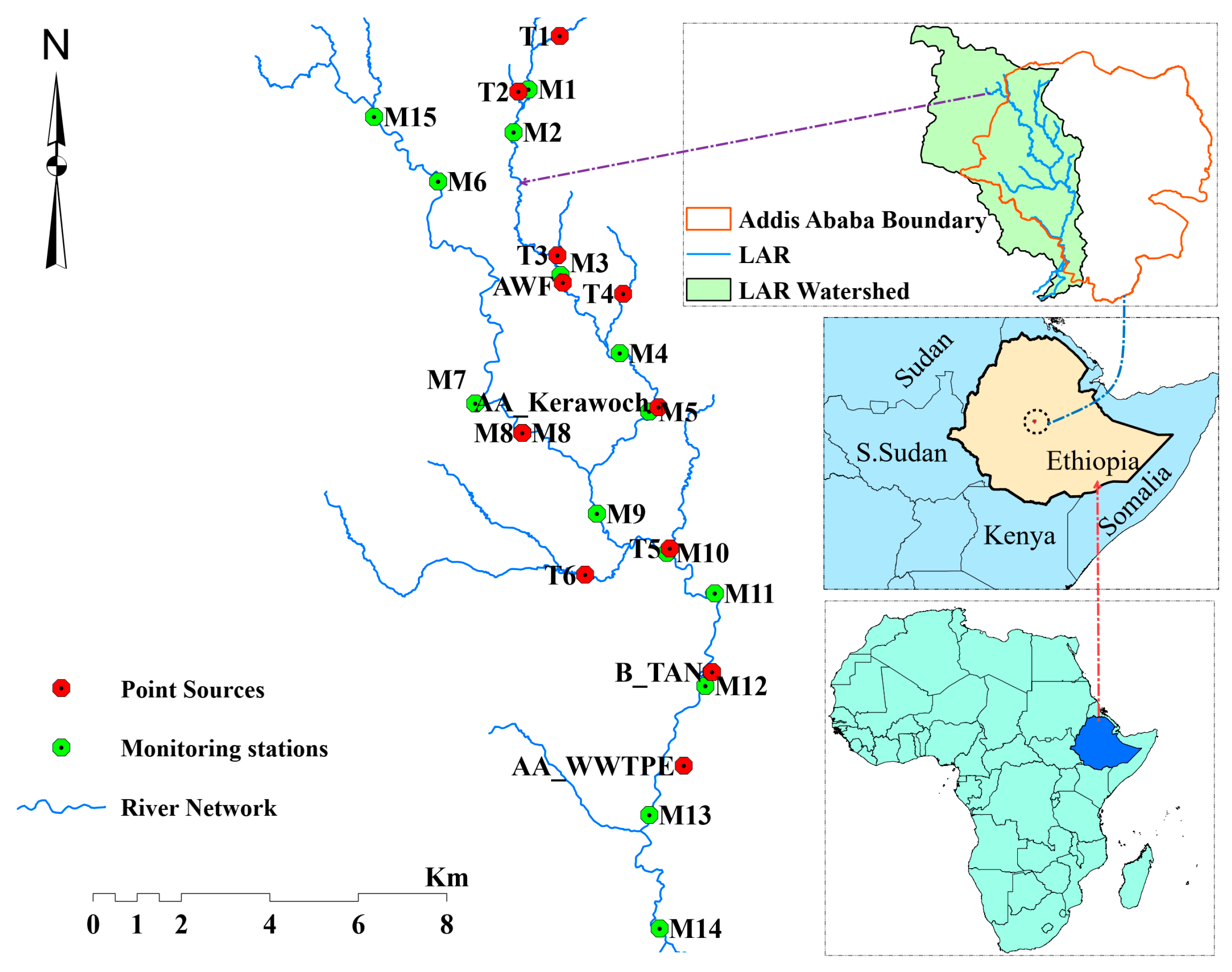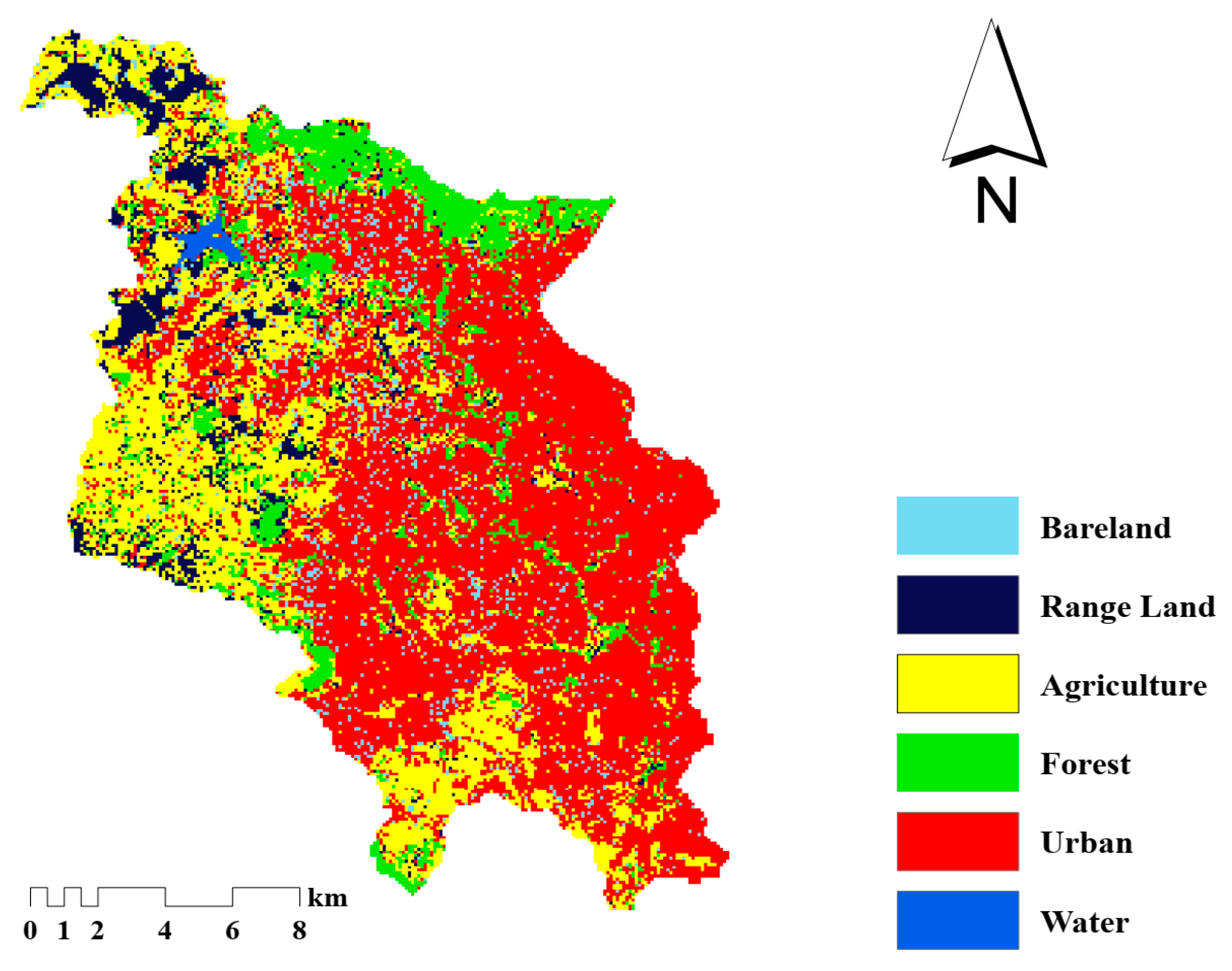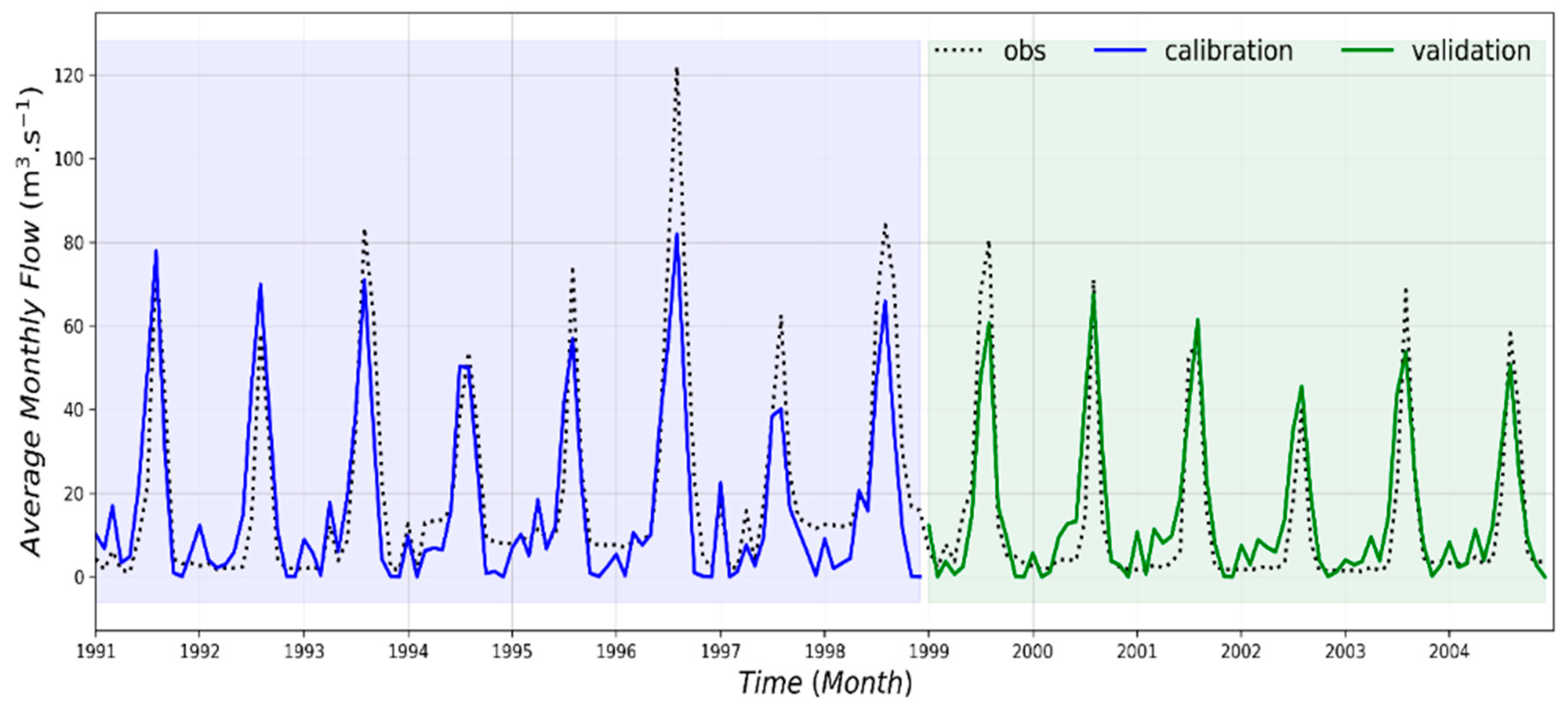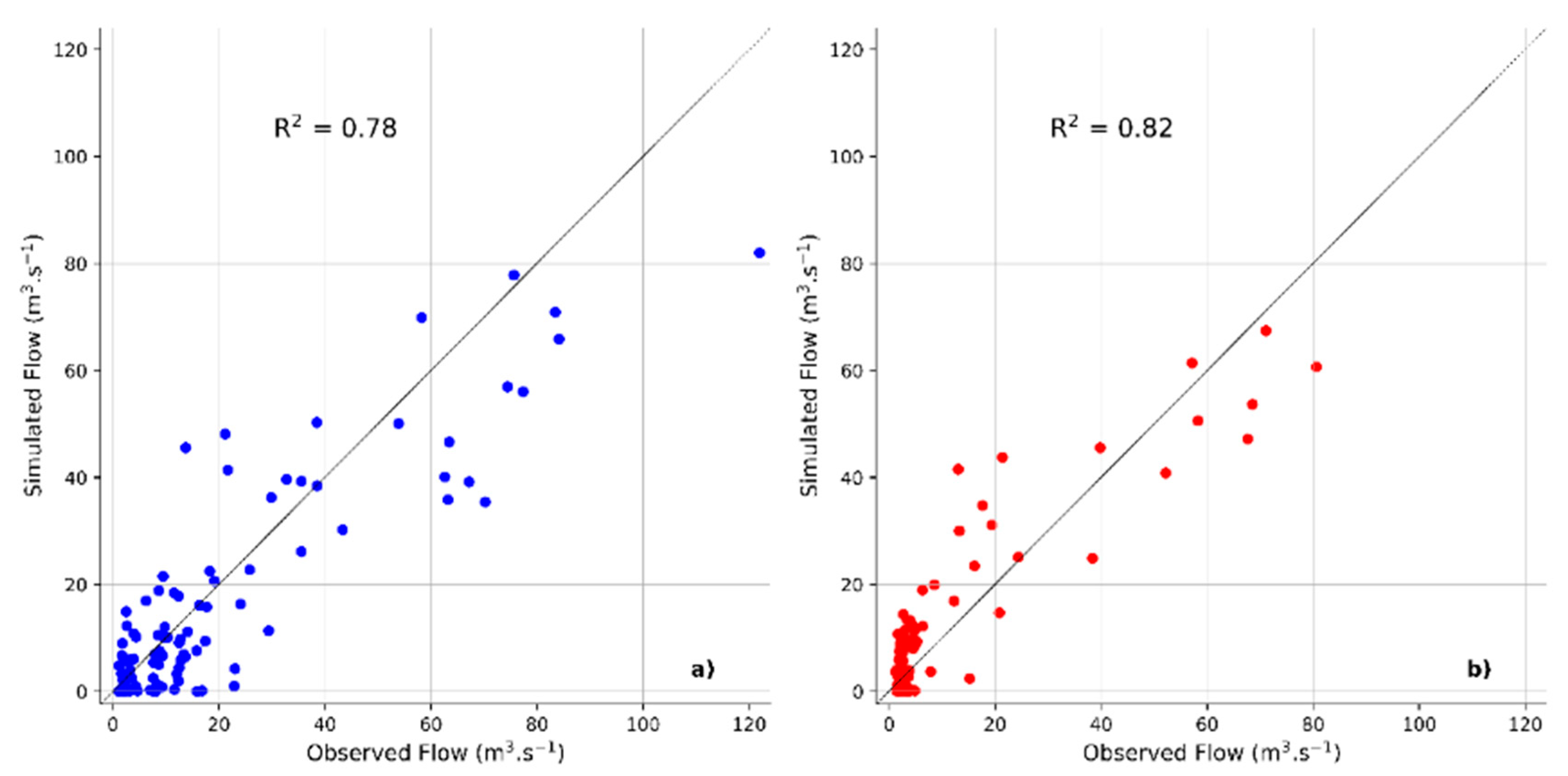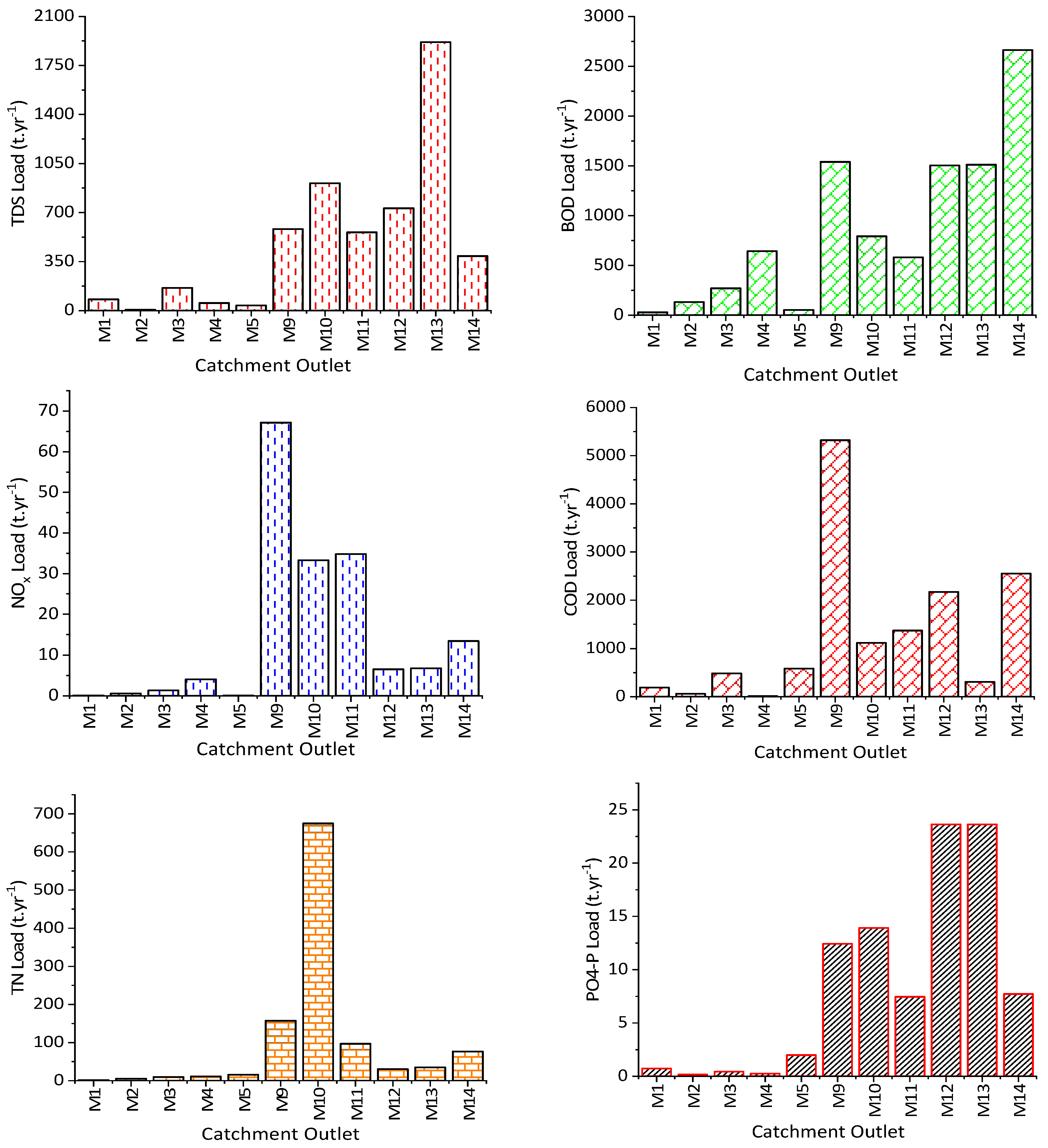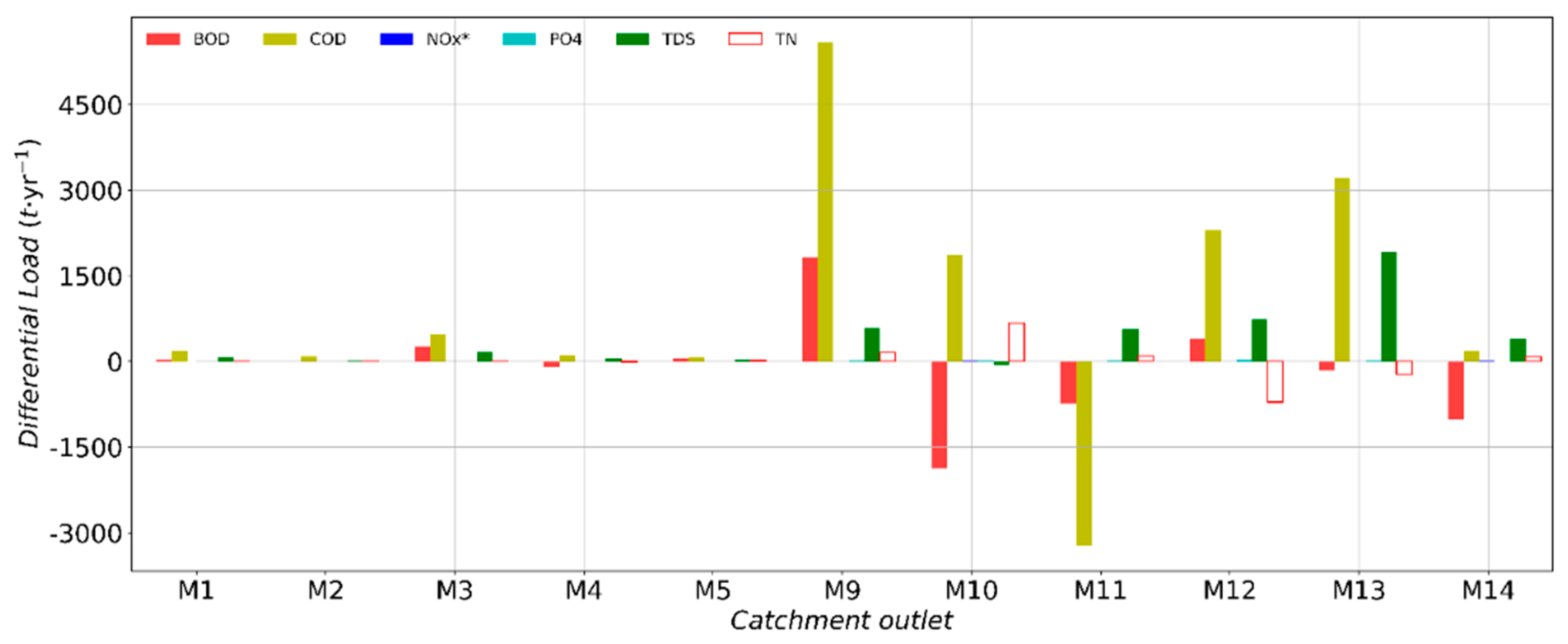The results in this section are presented in a way that the pollutant load for selected segments of the LAR and monitoring stations of the catchment outlets are represented. The discussion mainly focuses on the major pollution hotspots in the watershed and the pollutant contribution of various land uses were quantified.
3.1. Point Sources Load in LAR
The pollutant load from point sources in LAR was much smaller than the tributaries load due to the relatively higher flow rate and pollution level of the tributaries than the point sources. However, stations M3 to M11 (
Figure 1) were heavily loaded by point source pollution that contributes significant pollutant loads to LAR including, the soft drink industry, wine industry, abattoir, tobacco factory, and hospitals. Similarly, the heavily polluted Mesalemya stream that joins the main river upstream of outlet M3 and a tributary that crosses densely populated urban center, Merkato, and receives many wastewaters from industries joining the main river at M4 have highly augmented the pollutant load in LAR. Besides, the load contributed by the Addis Ababa Abattoir near Kera Beg Tera (M5) was found to be very high due to significantly higher water consumption from the slaughterhouse that generates wastewater with a higher flow rate.
Table 5 summarizes the load contributed by point sources to the LAR. Almost all of the point sources near LAR discharging the wastewater directly to the river have either no treatment plant or couldn’t fully operate. From the point source load summary on
Table 5, it can be apparently seen that the contribution of stations T6, AA_Kerawoch, AA_WWTPE, and M8 were quite significant for the LAR organic and nutrient pollution.
3.2. Flow Simulation and Pollutants Flux in LAR
The SWAT calibrated at BAR was used to generate flow in LAR subcatchment outlets where the model output along with the instantaneous flow and constituent concentration was used in FLUX32 software to calculate the pollutant flux (load). Accordingly, the SWAT simulated the flow quite well in
Figure 3 and
Figure 4 with an R
2, NSE, and RSR value of 0.78, 0.76, and 0.49 during calibration and 0.82, 0.8, and 0.45 during validation, respectively. The model performance indicators above (R
2, NSE and RSR) were good enough to interpret the model output for any purpose. From
Figure 3, it can be seen that the deviation between the SWAT model simulated and observed peaks. This could primarily be due to the model performance. The hydrological model performance determined by the Nash-Sutcliff (NSE) was found to be 0.76 and 0.78 during calibration and validation in the study area, which is good enough to interpret the model output [
50] and the deviation between the observed and simulated flow is interpreted by the error. Similar results were reported elsewhere with similar trends between the model simulation and observation in the works of Abbaspour et.al. [
51], Rostamian et.al. [
52], and Shawul et.al. [
53]. Sometimes the time lag between the small rainfall event and the main rain event could dictate the variation between the model simulation and observed values. This explanation is supported by the study conducted by Li et.al. [
35], who used hydrological and water quality model, HSPF, where a similar trend with this study between the model simulated and observed flow was observed. The spatial location of rain meters and the heterogeneity among rainfall stations could also determine the deviation. Though there was deviation between model simulated and observed values at some peak points, the model performance indicators (specifically the Nash-Sutcliff) could suggest that the model output can be interpreted with a good accuracy. The SWAT-generated subcatchment outlet flow was used to calculate the load in FLUX32. Accordingly, the flow-weighted concentration calculated by method 6 (Equation (1)) was < ±20% of all other methods in FLUX32. The residual plot of bias (as slope) for flow, date, and month at each catchment outlet in LAR was in the range of 0–0.05, which is quite acceptable. Similarly, the plot of slope significance was in the range of 0.88–0.99 ≈ 1. The coefficient of variation (CV) is recommended to be in the range of 0–0.2 during flow-weighted load calculation and in LAR, the CV has resulted in the range of 0.03–0.101, which is quite good. During pollutant load calculation in LAR using FLUX32, the presence of the outlier was checked statistically by testing the significance level,
p ≤ 0.05.
3.3. Chemical Mass Balance and Pollutants Differential Load in LAR
Once the loads were calculated at each of the subcatchment outlets by FLUX32, a CMB analysis was performed following an upstream–downstream mass balance approach (Equation (2)) to determine the differential load. A similar approach was also followed by [
33,
34,
54]. From the calculated CMB analysis at each monitoring station (
Table 6), we found that the prevalence of differential uncharacterized nonpoint source load at the middle and downstream segment of the LAR with highest calculated differential load were BOD, COD, and TDS, which had shown highest loads at segment outlets M9, M10, M12, M13, and M14, and the influence of uncharacterized nonpoint sources were found to be significantly high (
Figure 5). The areas were dominated by urban set-ups (industrial with both large and small scale), residential settlement (usually informal), and agricultural (predominantly small scale) land uses. The organic pollution contribution from the nonpoint sources prevailed in the study area where the maximum calculated differential BOD load was observed at M9 with 1833.2 t/yr, where the station is located downstream of two highly polluted but large streams that make a confluence. On the other hand, the maximum COD differential load from the nonpoint source was observed at the same station with a calculated load of 5588.7 t/yr contributed by the subcatchment having an area of 826.419 ha, followed by M13, M12, and M10, which had contributed an annual load of 3217.2 t, 2306.9 t, and 1859.55 t, respectively. Similarly, high BOD depletion was observed at downstream stations M10 (1867.49 t/yr), M11 (738.49 t/yr), and M14 (1007.76 t/yr), where the impacts of nonpoint sources were assumed to be insignificant, showing that the river is going through a high rate of recovery, possibly due to morphometric effects and the improved self-purification capacity of the river [
55].
High PO
4-P differential load was calculated at most downstream stations characterized by small-scale urban agricultural activities prevailing at M12 (23.63 t/yr), followed by M10 (12.92 t/yr) and M9 (12.42 t/yr). Besides, the area is characterized by a large number of small-scale industries, dumping sites for informal solid waste including bio-waste, wastewater treatment plant effluent, and animal remains. On the other hand, from
Table 6, it can be seen that high differential TN load from uncharacterized nonpoint source was calculated at monitoring stations M9 (157.2 t/yr), M10 (674.79 t/yr), and M11 (97.02 t/yr), whereas stations M4, M12, and M13 were identified as areas with TN sink. COD, BOD, TDS, and TN were found to be dominant nonpoint source load contributions and were found in large quantities prevailing in the middle and downstream segments, indicating the increased impact of washouts from agricultural and urban land uses. The CMB analysis in LAR revealed that most of the organic waste load were concentrated at the middle segment of the river, whereas the sink for these pollutants was found far downstream. The CMB analysis in LAR also showed that NO
x, TN, and BOD had sinks at most of the LAR monitoring stations calculated at outlets. Stations M9–M14 are the recognized sink areas for organic pollutants and nutrients located in the middle and downstream segments of LAR. A similar finding was reported by Elósegui et al. [
56], where most of the nutrient load in river Agüera in Northern Spain was retained in the middle of the river. The station M11 is a place where the organic pollutants are highly degraded and hence the area was identified as a major nutrient sink. It is a place where a public protected park (Biheretsige Park) is located, which could reduce the impact of nonpoint source load contributions. Relative to the downstream and middle catchments, the upstream segments have low nonpoint source load contributions, where a similar result was also found by Jain et.al. [
33] on Hindon River, India. This could be due to relatively low flow, less anthropogenic influence in the area, and the presence of buffer zones such as grass strips and urban forests.
From the CMB analysis (
Figure 6), it can be seen that most of the constituents in the upstream section of the LAR (M1–M5) had minimum differential load, showing reduced impact of nonpoint source pollution. Conversely, differential loads of BOD, TN, and NO
x have shown most of the sinks were observed at the middle and downstream segment of LAR, where riversides are protected by grasses and plants, predominantly at M10 and M11. Maximum loads of nutrients, such as TN, NO
x, and PO4-P, were recorded at M10, which was also identified as a major sink for BOD. Similarly, M14 was found as an area where both TN and NO
x have shown a positive differential load. The station is found downstream of the discharge point of wastewater treatment plant effluent and is also characterized by small-scale urban agriculture.
3.4. Integration of CMB-PLOAD and Uncharacterized Nonpoint Source Load
Loads calculated at selected LAR subcatchment outlets (monitoring stations) by CMB were used for PLOAD calibration and the selected ECf for LAR was used as an initial estimation for calibration. During the calibration of PLOAD in Excel Solver, the ECf were used as independent variables and the ranges were constraints by setting the upper and lower bounds of the ECf based on the literature for optimization. At the initial stage of calibration and preoptimization, the total percentage error between the model-predicted and measured load at all monitoring stations for COD, BOD, TDS, NOX, PO4-P, and TN were 3680.6%, 2965.64%, 767.97%, 446.8%, 750.40%, and 899.36% respectively. After the optimization of the ECf in Solver, the average percentage relative error dropped to 12.16%, 3.98%, 0.53%, 26.86%, 8.9%, and 29.22%, respectively. On the other hand, the sum of errors in COD was found to be higher than BOD, which resulted in a total sum of error at 3680.6% preoptimization, where much was attributed by station M5, at which point the PLOAD underestimated both constituents at the station.
The PLOAD prediction for TDS was relatively accurate, where the total relative error at all monitoring stations before optimization was found to be 767.97%, which sharply dropped to 0.53% after optimization. Unlike other parameters, the PLOAD model has overestimated the TDS load in the upstream section of the LAR (M1–M5, and M9), whereas the model underestimated the PO
4-P load in LAR at the downstream segment of the river. High total errors were recorded at smaller catchments of LAR than the bigger catchments, and Zinabu et.al. [
1] also came up with a similar finding in Kombolcha catchment, Ethiopia. From the optimized ECf, we found that urban and agricultural land use ECf varies greatly with varying urban land-use types and has shown a significant variation spatially. The water body land-use showed minimum change over the loading of constituents across the monitoring stations, which could be due to less area coverage in the watershed.
The PLOAD was rerun using the median and mean value of the optimized and calibrated ECf. Though the median ECf gave minimum total percentage error relative to the mean value, high variation in the ranges of the ECf made the load vary greatly, and hence the loads calculated by both mean and median ECf were not acceptable. The optimized ECf values revealed that the use of average and median value resulted in an underestimation of pollutant load at some catchment outlets, whereas overestimation on others. Thus, the use of area-specific ECf was relatively acceptable and was found effective in better estimation of pollutant loads in LAR. The study conducted by Shrestha et al. [
11] also recommended the use of area-specific, and development of local, ECf for effective pollutant load calculations. The optimized values can then be interpreted well for LAR and used for the management of the nonpoint source pollution load in the catchment. Similarly, the PLOAD was validated for a different data set without change in the optimized export coefficient and the error calculated from the model was acceptable enough for further interpretation. Accordingly, the percentage error between the PLOAD predicted and measured values for COD, BOD, TDS, NO
x, PO
4-P, and TN during validation were found to be 16.41%, 7.06%, 1.77%, 13.23%, 5.4%, and 18.83%, respectively.
The calibrated pollutant ECfs showed that the urban land uses had significantly varying export coefficients. Accordingly, the pollutant loading rate for urban land use ranged from 42.1–2083 kg/ha/yr, 63.3–2012 kg/ha/yr, and 0.49–1.6 kg/ha/yr for COD, TDS, and PO
4-P, respectively, varying with the subtype of urban land use (such as residential, commercial, industrial) and location. The urban land uses dominated by residential settlements and industries do have high loading rates, whereas other urban land uses have relatively lesser rates. Similarly, the urban land use pollutant ECf for BOD and NO
x also vary greatly, ranging from 120–1950.55 kg/ha/yr and 0.1–47.32 kg/ha/yr respectively. The high variation in ECf spatially is due to the high difference in the impact of nonpoint sources among various urban land uses. The upstream urban land uses have less pollutant loading than the middle and downstream catchments (
Table 7). The agricultural land use for all the constituents was sensitive in controlling the impact of the pollutants load on the LAR. Though the contribution of agricultural land for nonpoint COD load was quite constant with a range of 79.64–81 kg/ha/yr, an appreciable magnitude of ECf for TDS with 76.4–2005 kg/ha/yr would suggest that the agricultural land use varies spatially in contributing the TDS loading rate. Similarly, PO
4-P, NO
x, and BOD have an annual loading rate of 7.72–8.1 kg/ha, 0.1–30.16 kg/ha, and 60.25–60.8 kg/ha/yr from the agricultural land use.
